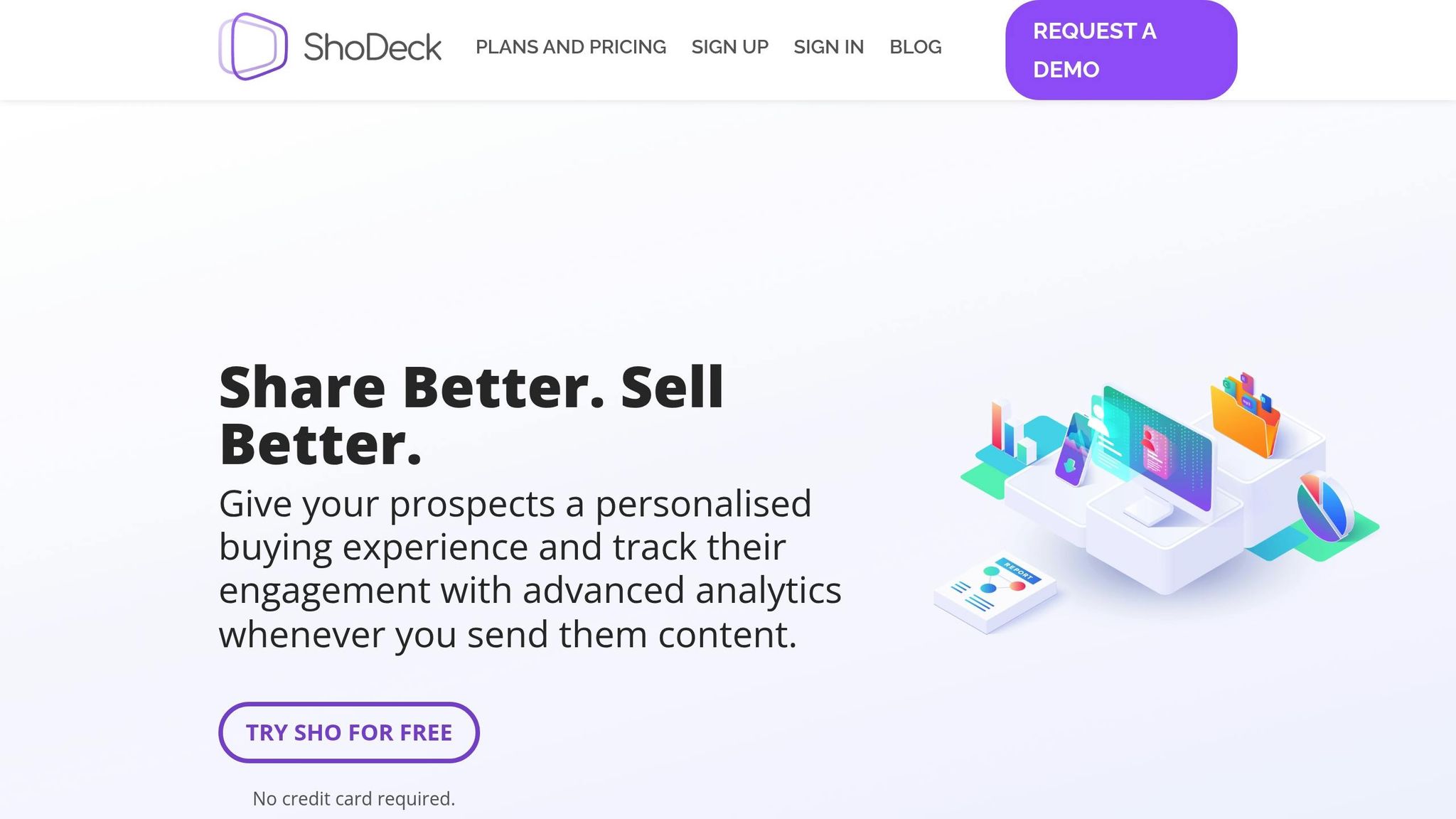Buyer portals are transforming B2B sales by centralizing communication, simplifying processes, and boosting revenue. With 80% of B2B sales expected to occur through digital channels by 2025, understanding their ROI is essential. Here’s what you need to know:
- What They Do: Buyer portals streamline sales by providing a secure, personalized hub for sharing demos, pricing, and deal-related content.
- Why They Matter: 76% of buyers abandon deals without a personalized experience, and portals help prevent this by improving engagement and collaboration.
- How to Measure ROI: Key metrics include sales cycle duration, lead conversion rates, buyer engagement, and overall revenue impact.
Quick Tip: Use tools like ShoDeck to track metrics, match content to buyer stages, and improve team communication for better ROI. Let’s dive into how you can measure and optimize your buyer portal’s success.
Why Video Is Your Best Sales Rep: SaaS GTM Strategy …
What Are Buyer Portals in B2B Sales?
Buyer portals are specialized digital platforms designed to streamline how B2B sales teams interact with prospects. These portals create a personalized space where all deal-related conversations, content, and stakeholder collaborations are centralized in one easily accessible location.
Main Functions of Buyer Portals
Buyer portals enhance the sales process by acting as a centralized hub for essential sales materials. These include files, images, videos, and even web embeds, all of which can be updated instantly across multiple portals.
"Salespeople can deliver a customised content portal for your buyers to engage with and share among their stakeholders. This dedicated content page is a far better user experience than receiving bulky attachments that get lost in long email threads." – ShoDeck
Streamlining the Sales Process
These portals simplify the buying journey, making it quicker and more engaging for prospects.
"ShoDeck helped us increase win rates, engage more decision makers, eliminate email trails, and improve buyer collaboration." – Jim Hilbert, SVP, Global Revenue and Customer Success, Aryaka
Key Features of ShoDeck

ShoDeck’s buyer portal offers a range of tools to improve sales efficiency:
- Content Management: Includes custom branding, multimedia support, and real-time updates.
- Engagement Tools: Features like live chat and the ability to invite stakeholders.
- Analytics: Tracks metrics such as viewing activity and engagement levels.
- Collaboration: Enables multiple stakeholders to access the portal and communicate in one place.
These tools are designed to enhance communication and make tracking ROI easier, a topic we’ll dive into in the next section.
"ShoDeck is a great platform for my reps to make sure they are following the critical steps in the GoodData Sales Process. It also allows us to bring our prospects closer to us by allowing effective communications through numerous visuals to help both GoodData and our prospect understand the steps to partner. It helps set us apart in the marketplace." – Bill Lapp, VP Sales Engineering and Enablement, GoodData
With these features in mind, we’ll now look at the key metrics you need to track to measure ROI effectively.
Key ROI Metrics for Buyer Portals
After understanding ShoDeck’s features, it’s time to focus on measuring ROI using these critical metrics.
Sales Cycle Duration
Monitor the time it takes to move from initial contact to closing a deal, both before and after implementing the portal. This helps identify where the portal is saving time during specific stages of the sales process. An ROI dashboard can highlight these changes and reveal areas that might still need improvement.
Deal Success Rates
Evaluate how many leads turn into paying customers to assess the portal’s impact on deal closures. The Lead Conversion Rate is a key indicator of how effective the portal is at driving successful outcomes.
Tracking Buyer Activity
Keep an eye on these metrics to understand how buyers are interacting with the portal:
- Shares
- Utilization rate
- Views
- Engagement rate
- Engagement quantity
- Individual buyer engagement
Sales Revenue Impact
Use your ROI dashboard to monitor metrics like real-time revenue, contributions from partners, cost breakdowns, and historical trends. These insights provide a clear picture of how the portal is influencing overall revenue.
Next, dive into strategies for tracking and improving these metrics after launch.
sbb-itb-c9e7538
Methods to Track and Improve ROI
Once you’ve defined your ROI metrics, it’s time to track your portal’s performance and work on improving returns. Here’s how: start by establishing pre-launch benchmarks, monitor post-launch changes, and use ShoDeck analytics to fine-tune your strategy.
Setting Initial Metrics
Begin by capturing your current sales metrics to create a solid baseline:
| Metric | Pre-Launch Baseline |
|---|---|
| Sales cycle length | Average days to close |
| Deal size | Average revenue per sale |
| Conversion rate | Percentage of leads closed |
| Customer acquisition cost | Total cost per new customer |
| Time allocation | Hours spent per deal phase |
To get accurate benchmarks, export data from your CRM covering the last 6–12 months.
Measuring Results After Launch
- Use an ROI dashboard to monitor changes on a weekly and monthly basis. This dashboard should pull data from your CRM, marketing automation tools, and partner platforms.
- Calculate ROI using these formulas:
- Net Profit = Generated Revenue – Investment Cost
- ROI (%) = (Net Profit / Investment Cost) × 100
For example, if you invest $50,000 in a portal and it generates $150,000 in revenue:
- Net Profit = $150,000 – $50,000 = $100,000
- ROI = ($100,000 / $50,000) × 100 = 200%
Using ShoDeck’s Data Tools
ShoDeck offers advanced analytics to enhance your tracking efforts:
- Page analytics to identify top-performing content
- Real-time notifications for instant buyer activity updates
- Time-on-page and interaction metrics to gauge engagement
- Live chat data to measure response effectiveness and outcomes
Make it a habit to review your analytics dashboard weekly to stay on top of performance trends and make informed adjustments.
Tips to Increase Portal ROI
Once you’ve set up metrics tracking, it’s time to take action. Use these strategies to improve your portal’s performance.
Matching Content to Buyers
Tailor your content to match where your buyers are in their journey. This approach helps increase engagement and conversions by providing the right information at the right time.
- Awareness Stage: Use blog posts, infographics, and short videos to educate your audience and address their initial pain points.
- Consideration Stage: Share case studies, interactive demos, webinars, and eBooks to highlight your value and help buyers evaluate their options.
- Decision Stage: Provide demo videos, pricing documents, and testimonials to support final purchasing decisions.
- Post-Purchase Stage: Offer onboarding guides, update newsletters, and a knowledge base to retain customers and keep them engaged.
Create detailed buyer personas that outline each segment’s needs, challenges, and preferences. This ensures your content connects with your audience at every stage of their journey.
Team Communication Tools
Leverage ShoDeck’s features like real-time messaging, live chat, and activity notifications to keep deal discussions and buyer support in one place. Instantly update shared resources and monitor response times to avoid delays. Faster communication can shorten sales cycles and improve conversion rates.
Regular Performance Reviews
Set up regular check-ins to review ShoDeck’s analytics alongside feedback from your sales team. Use these insights to fine-tune your content, adjust workflows, and ensure you’re meeting buyer expectations. These ongoing improvements can lead to better long-term results.
Conclusion
Boost ROI by aligning your content strategy, improving team collaboration, and continuously refining your approach. When marketing and sales teams collaborate effectively using the portal, they deliver a cohesive buying experience that leads to stronger results. ShoDeck’s analytics and collaboration tools simplify this process, helping you turn data into actionable steps that lead to measurable growth.





0 Comments